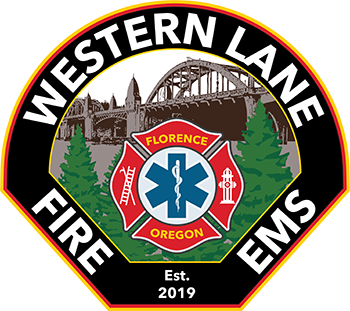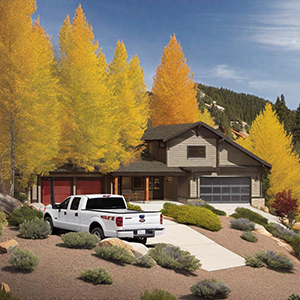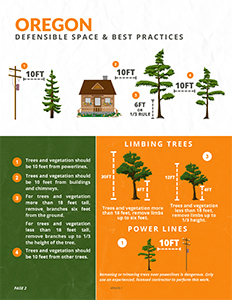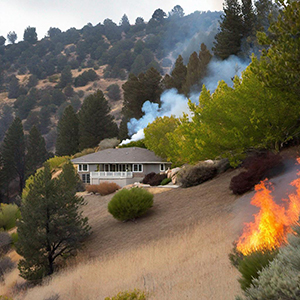Defensible Space
Before filling out the form please read on what you can do to prepare your property with Defensible Space
You can either submit the form electronically or you can call our office at 541-997-3212 to request an assessment
Create a Defensible Space Around Your Home!
What is defensible space? A defensible space is an area, either man-made or natural, where the vegetation is modified and maintained to slow the rate and intensity of an advancing wildfire. Creating a defensible space also includes taking steps to protect your home from the ember storm that comes with a wildfire.
How do structures ignite?
Structures ignite when:
-
- Nearby radiant heat is so intense it ignites the structure.
- Fire burns right up to and touches the structure.
- Firebrands collect in an exposed area and begin burning on or near the structure.
What is the purpose of defensible space?
- To keep high intensity (crown) fire at least 100 feet away from a house by changing the fuel density so it can’t support that kind of fire.
- To keep low intensity (ground) fire at least 30 feet from house, keeping both radiant heat and direct flame contact from attacking the house.
- To clean up and protect areas where firebrands and fuels can collect.
Here’s how:
Thin tree and brush cover within 30 feet of the house.
- Separate trees so their canopies are at least 10 feet apart.
- Stands of 2 or 3 trees should be separated from the nearest tree or structure by at least 30 feet.
- If the house is on a slope, increase the defensible space on the downhill side. Calculate defensible space as follows: 3 feet for every 1 degree of slope.
- If the house is located at the crest of a steep hill, thinning should be done for at least 100 feet below the crest.
Limb up all trees within the defensible space.
- Prune branches to a height of 10 feet above the ground.
- Remove shrubs, small trees, and other potential “ladder” fuels (fuels which could allow a fire to climb into the crown of a tree) from beneath trees.
Mow dry grasses.
- Keep all grass and weeds within the defensible space at a height of 2 inches or less, especially during periods of high fire danger.
Remove slash and ground litter.
- Remove all dead limbs, leaves, the debris created by thinning and limbing, and other ground litter within the defensible space.
Trim branches near the house.
- Remove branches which extend over the eaves of the house
- Remove branches within 15 feet of a chimney.
Clean roof, gutters, and decks.
- Clean your gutters regularly.
- Remove all pine needles and leaves from where they gather on the roof, in the corners of decks, and anywhere they accumulate near or against the house. These can provide excellent tinder for the ember storm created by wildfires.
-
- Continue to thin trees within at least 100 feet of the house, separating them so that, at a minimum, crowns do not touch each other, and preferably so that there is a distance of 10 feet between crowns. The further out you can extend this thinning, the better.
Other things you can do to protect your house.
- Stack firewood at least 30 feet away from your house.
- Locate propane tank either on the downhill side or the same level as the house and at least 30 feet away from your house.
- Install multi-pane or tempered glass windows, especially for picture windows and sliding doors. These will withstand more heat before breaking than single pane windows.
- Use wire screens on all windows to stop embers from getting inside if the windows break during a wildfire. The mesh holes must be no larger than 1/8″ to stop embers. Do not use fiberglass screens, which will melt.
- Cover exterior attic, soffit and underfloor vents with wire mesh to prevent sparks from entering the house. The mesh holes should be no larger than 1/8″.
- Enclose or screen off porch, foundation, roof, and attic openings to keep debris from accumulating underneath, and keep areas under decks free of vegetation. Regularly clean these areas and anywhere needles accumulate.
- Protect windows and sliding doors with nonflammable shutters, and use fire resistant drapes or blinds on the interior, especially on the side of the house which is most likely to be exposed to fire (typically the downhill side).
- Install a chimney screen or spark arrestor, and inspect and clean your chimney on a regular basis.
- Equip your home with smoke detectors and at least one 10 pound ABC-class fire extinguisher.
- Post your address/house number so that it is clearly visible from the road, from both directions, and not obscured by brush and trees. (See the Address Signs page for information on how to obtain an address sign from the Western Land Fire and EMS Authority.)
For additional information on wildfire hazards and what you can do to reduce them, contact the Western Lane Fire and EMS Authority Fire Marshal at (541) 997-3212, or use the form below to request to have members of the fire department perform a wildfire assessment on your lot.





